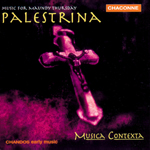The mystique which surrounded the ceremonies and music of the Sistine Chapel was very powerful. At no time was this more potent than during the last three days of Holy Week with the long Tenebrae services.
Meaning ’darkness’, the Latin word Tenebrae referred to the twilight timing of these services (each of which was a combination of Matins and Lauds). The only lighting in the chapel came from a triangular candle stand placed upon the altar. After each psalm of the service one of the fifteen candles was extinguished. Following the Benedictus on Maundy Thursday the final candle - still burning - was removed and hidden behind the altar, being replaced only after the recitation of the Miserere in near-total darkness.
Giovanni Pierluigi da Palestrina was one of the leading composers of the late sixteenth century and was particularly prolific in the composition of Masses and motets. A key figure in Catholic music-making in the age of the Counter-Reformation, Palestrina succeeded in cohesively assimilating the richly developed polyphonic technique of his French-Flemish predecessors.
All of the chant featured in this recording has been taken from Giovanni Guidetti’s rhythmically notated edition of chant for the Holy Week, which was published in Rome in 1587 and dedicated to the Pope.
















 My Wish List
My Wish List




